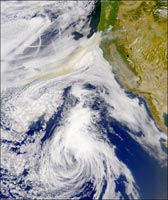Study: Ships' Smoke Degrades Coastal Air Quality
 Chemists at the University of California-San Diego have measured for the first time the impact that dirty smoke from ships cruising at sea and generating electricity in port can have on the air quality of coastal cities.
Chemists at the University of California-San Diego have measured for the first time the impact that dirty smoke from ships cruising at sea and generating electricity in port can have on the air quality of coastal cities.
The scientists report in an August edition of the journal Proceedings of the National Academy of Sciences that the impact of dirty smoke from ships burning high-sulfur fuel on some days accounts for nearly one-half of the fine, sulfur-rich particulate matter in the air.
Their results have particular significance for the state of California, which will require, beginning next July, all tankers, cargo, and cruise ships sailing into a California port switch to more expensive, cleaner-burning fuels when they come within 24 miles of the coast. Similar international rules requiring clean-burning ship fuels are set to take effect in 2015.
"This is the first study that shows the contribution of ships to fine particulates in the atmosphere," said Mark Thiemens, dean of the Division of Physical Sciences and a professor of chemistry and biochemistry at UCSD and head of the research team. "Ships are really unregulated when it comes to air pollution standards. What we wanted to find out was the contribution of ships to the air pollution in San Diego. And what we found was a surprise, because no one expected that the contribution from ships of solid sulfur-rich particles called primary sulfate would be so high."
Primary sulfate, or SO4, is produced when ships burn a cheap, sulfur-rich fuel called "bunker oil." Most of the sulfur emitted by ships burning bunker oil is released as sulfur dioxide, or SO2, a gaseous pollutant which is eventually converted to sulfate in the atmosphere. But although SO4 may be a smaller component in ship emissions, the scientists say, these primary sulfate particulates are particularly harmful to humans, because they are especially fine microscopic particles, less than 1.5 microns or millionth of a meter in size. As a result, they can travel extremely long distances because they stay in the atmosphere for longer periods and, unlike bigger dust grains and particles that are removed by the body when breathed, remain in the lungs.
"The importance of primary sulfate is usually ignored in assessments of the impact of ship emissions on air quality because less than 7 percent of all sulfur emitted by ships is found in primary sulfate particles," said Gerardo Dominguez, a postdoctoral researcher at UCSD and the first author of the paper. "But our results suggest that this component of ship emissions is important and should not be ignored in the future. Knowing how much sulfate from ships is in the air will also allow us to better understand what happens to the other 93 percent of sulfur emitted by ships."
Working with Thiemens, Dominguez developed a chemical fingerprinting technique that allowed the scientists to distinguish primary sulfate from ship smoke from the tailpipe emissions of trucks, cars, and other sources. This was done using an oxygen-isotope technique developed by Thiemens that allows scientists to determine the signature of sulfate molecules made in the atmosphere. The researchers discovered that primary sulfates from ship engines incorporated molecular oxygen (the type we breathe in to live) and are easily distinguishable.
Sampling air at the end of the pier at the UC San Diego's Scripps Institution of Oceanography in La Jolla, the scientists found that the smoke from ships contributed as much as 44 percent of the sulfate found in fine particulate matter in the atmosphere of coastal California. On the days when the proportion of ship sulfate approached one-half of the fine particulate matter, the scientists determined from wind direction and speed calculations that ships burning high sulfur fuel in the Los Angeles, Long Beach, and San Diego ports were a major influence.
Other UCSD researchers involved in the study were chemist Terri Jackson, graduate student Lauren Brothers, and undergraduate students Burton Barnett and Bryan Nguyen. The research project was financed by grants from the California Air Resources Board, the Camille and Henry Dreyfus Foundation, and the UC Office of the President.